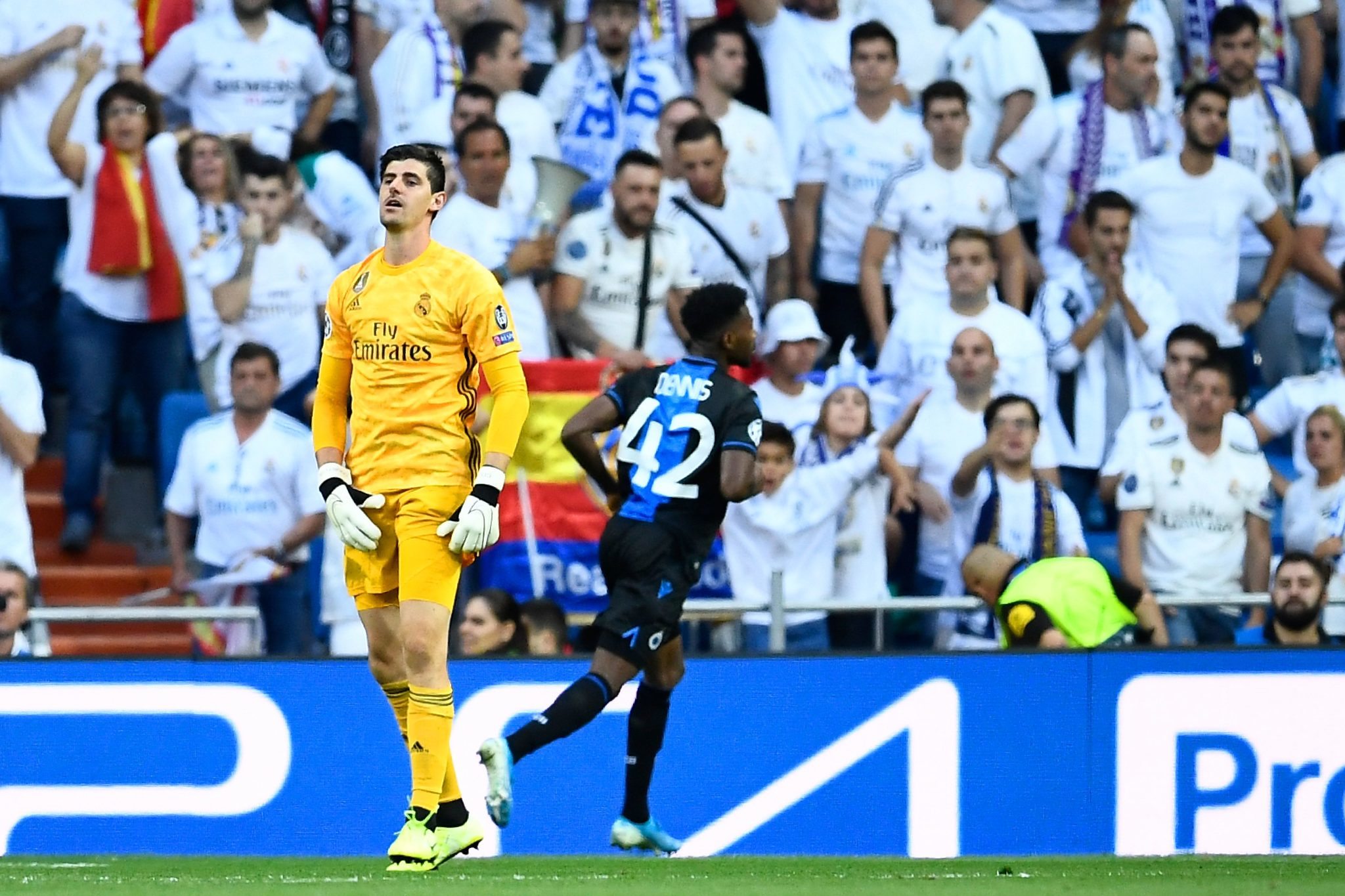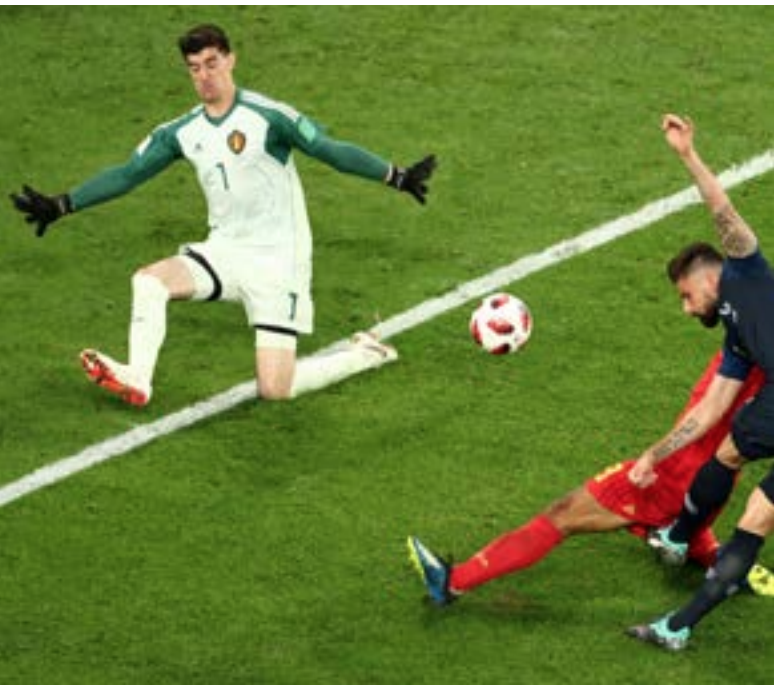Why does Courtois concede between the legs and how does he compare to a modern goalkeeper?

Thibaut Courtois’ recent performances for Real Madrid have sparked controversial opinions among the critics and fans on social media. In the home game of the Champions’ League group stage against Club Brugge Zinedine Zidane made the decision to replace him with Alphonse Areola due to the Belgian feeling unwell. By that time Real Madrid’s number thirteen had already conceded two goals from three shots on target he faced in the first half and the impatient Bernabéu crowd had started whistling.
While not all goals conceded by Courtois come particularly from his poor judgment, there is a certain pattern in the way they were conceded, which might be worth looking at more in-depth.
Courtois has conceded on average 1.37 goals per game playing for Real Madrid from different types of shots. Every one of those goals gets scrutinized by the fans and we often see a certain meme posted on social media which originated from the number of goals conceded between the legs by the Belgian keeper.
Now, this is not the statistics an average fan can find going through WhoScored or Squawka records but Thibaut Courtois concedes those often enough for many to consider them his trademark.
These are just some of the notable ones:
- from Leonel Messi (Barcelona – Atletico, 2011)
- from Aaron Ramsey (Belgium – Wales, 2014 World Cup qualification)
- from Edinson Cavani (PSG – Chelsea, 1/8 Champions League, 2016)
- twice from Messi (Barcelona – Chelsea, 1/8 Champions League, 2018)
- from Santi Cazorla (header, Villarreal – Real, 2019)
- from Antoine Griezmann (Atletico – Real Madrid, 2019)
- from Sergi Guardiola (Real – Valladolid, 2019)
One of these goals led to a dispute between Courtois and Louis van Gaal. In 2018, the Dutchman analyzed the goalkeeper’s actions after getting nutmegged twice in Barcelona: “The game turned upside down after Courtois’s terrifying mistake. In my opinion, this is just a nightmare. If his coach was Frank Hook (the legendary Dutch goalkeeper coach), he would close his legs. That just should not be allowed to happen.”
Thibaut snapped back at Van Gaal: “When I hear so-called experts talking, I do not think they know anything about goalkeeping. For example, Van Gaal does not talk about goalkeepers. I know I am doing well and I am growing to my top form for the World Cup.”
It seems that Courtois does not think he made a mistake or, at least, does not believe that the mistake was that he did not close his legs.
This difference in opinions is staggering and explains many peculiarities in Thibaut’s game. Maybe goals conceded between the legs are not coincidental.
Let’s set this straight. A good starting point will be the analysis by the former Swiss international goalkeeper Pascal Zuberbühler he made for the FIFA technical report during the 2018 World Cup.
«On countless occasions, goalkeepers came out on top of one-on-one situations inside the penalty box through good positioning, timing and use of the “X-block” technique. Goalkeepers often used quick, short throws or passes to launch attacks», noted Zuberbühler.
Many teams defended compactly and deeply at the World Cup in Russia. «As a result, goalkeepers’ vision will have been reduced and they will have had less time to react. Deep defensive units also increase the risk of wicked deflections and the number of goals conceded in this manner», he stated.
Zuberbühler called Courtois the most effective performer of the tournament.
This photo was used by Pascal as an example:

The advantage of this technique – the goalkeeper covers the maximum area and complicates the attacker’s life. Disadvantage – it’s easier to concede between the legs. In other words, the goalkeeper is at risk of conceding an embarrassing goal but he closes up bigger areas and makes more frequent saves. In 90% of the cases, the attacker does not control the ball well enough to aim between the legs and not many will get through. Almost every such a goal is a bit of bad luck.
At the 2018 World Cup, Courtois shone like a star. He was the best goalkeeper of the tournament and a benchmark of a goalkeeper’s efficiency. At short distances, it’s quite possible to save most shots and never let in between the legs. Thibaut probably does not apply this technique intuitively, but most likely quite with some purpose, that is why he was irritated by the words of Van Gaal about closed legs.
So, does Courtois do everything right? Maybe not quite so. The football market has plenty of goalkeepers who concede less in general with a similar level of threat and are less likely to concede between the legs.
Now we finally got to the real problem:
Courtois has been playing at the top level for a long time, but still acts passively (doesn’t predict the episode, but reacts to it). But modern top clubs nowadays require an active manner of goalkeeping: coming out of the goal on time and preventing a difficult situation before the shot is fired. Instead of coming out at the right moment, like Alisson, Ederson or Oblak, Thibaut reduces everything to a reaction to a difficult situation (often 1v1).
The first cause of such mistakes is ability to read the game. Had Courtois been able to read the situation faster, the number of goals would have been reduced.
The latest goal from Guardiola is a good example of this trait. Thibaut’s starting position is deeper than that of «reading» goalkeepers, he is ready for any type of a shot, but not for a through ball.
[su_slider source=»media: 22131,22133,22134″ title=»no»]
Ederson recently had a reverse example. He conceded from a distance from Eric Lamela because he was too focused on coming out and intercepting the through ball. Balance is difficult. But it is easier to prevent 1v1 rather than long-range strikes. This is the strategy used by most modern top goalkeepers
[su_slider source=»media: 22135,22136,22137″ height=»400″ title=»no»]
Courtois is in a bit of a situation here: goalkeepers of weaker teams are less likely to appear in such circumstances because they are protected by sitting deeper defenses; goalkeepers of top clubs often play in an active manner and read episodes – and therefore come across this problem less often.
The second part of the problem is incorrect technique. The method of «X-block» is frequently used in futsal due to shorter distances between the goalkeeper and the attacker. Most of the time this method works well and the percent of saved due to it balls is quite high.
It has to be noted that the “X-block” technique can vary from the classic «cross» to an almost split. Top goalkeepers of today use its varieties and quite often when facing shots from close range and 1v1 situations.
However, in the Guardiola’s goal, we see Thibaut’s mistake – he did not close on the striker (at the time of the shot the distance between him and Guardiola was about 2.5-3 meters, which is a lot).
The technical element of this approach in itself is quite complex and time-consuming – the goalkeeper needs to advance, assume the right position (while correctly assessing which foot should be the supporting one), and, most importantly, reduce the distance to the attacker to a minimum.
What does Courtois do wrong? In my opinion, his flaws come from his advantages. He has long arms and legs, he is quite springy (due to his height and lightness of his legs) – quite an amazing goalkeeper for the “highlights” and top bin shot saves. In this aspect, he is one of the best in the world. He excels at thrown distribution, reading passes/crosses from the flank (where there is no direct threat to the goal, and that allows him to get difficult aerial balls). However, he is not very good at reading the direction of through balls (where there is a potential threat to the goal), and as a result, of situations arising from such episodes. This, most likely, is due to the characteristics of his physique, namely the lack of starting speed, the awkwardness of the first step. Similar to this, he has issues with the lower corners where it is very difficult to complete a jump, and the goalkeeper needs to become compact very quickly, which is not so easy to do with his long legs.
Here we could talk about Keylor Navas who might seem a complete opposite due to his sharp reflexes, reading the game, and compactness in preparation for the save. One might assume Navas sometimes concedes due to his height of 1,85 m which is not a lot by the goalkeeping standards but this trait might a blessing in disguise. Compared to him, Courtois is quite tall, almost 2 meters in height but is not fast enough to regroup due to the length of his limbs. It is quite interesting that attacking players do not often use another of his flaws – if he falls over defending a shot, it takes him longer to be able to get up and get into a position to deflect the second shot. In other words, after making the first save Courtois is played out, unlike Navas who can straighten up and keep jumping from side to side like a mad octopus deflecting consecutive shots.
And lastly, how does Thibaut compare to the «ideal» modern goalkeeper and what are their attributes?
The modern goalkeepers have undergone years of evolution to become all-rounded, active, ball-playing, shot-stopping crucial pieces of teams’ defensive mechanism. Presently new attributes are required from a keeper to be placed in the top echelon: intuitive reflex, distribution, sweeping up, athleticism, flawless positioning, footwork, and even big-game ability.
Bournemouth’s Asmir Begovic says goalkeepers «have to decide whether to catch or parry when dealing with the ball—especially as these days the ball is faster and moves more than it used to.»
Atletico Madrid’s Jan Oblak, Liverpool’s Alisson Becker, and Manchester United’s David De Gea are considered some of the best shot-stoppers. Alisson and Ederson Moraes are amazing handlers of the ball (be it parrying it, punching it clear, catching and keeping hold of it).
When it comes to reflexes Begovic also says De Gea and Real Madrid’s stopper Keylor Navas are «incredibly fast and their reflexes are some of the best in the world.» According to him three times Champions League winner Keylor Navas and Cech are the players who thrive performing in big-game moments.
Diego Alves can be noted for his penalty-saving ability.
Ederson, Barcelona’s Marc-André ter Stegen, and Bayern Munich’s Manuel Neuer can be named in the top three for the best distribution with feet due to their ability to start the attack and long pass precision.
Ederson, Ter Stegen and even Martin Dubravka of Newcastle United are known to excel at sweeping up.
Thibaut Courtois, as he has shown during the 2018 World Cup, possesses an above-average thrown distribution, passing, and accuracy (80% compared to 68% WC 2018 average). He has some of the attributes of the top modern goalkeepers but lacks in technique, big game ability and suffers from peculiarities of his physique.
Photo: Óscar del Pozo/AFP/Getty Images



